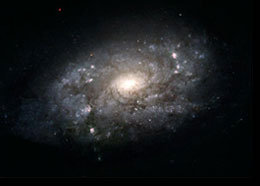|
A New Guide to the Galaxy
 |
|
| Panorama of the Milky Way galaxy as viewed from Earth in infrared light (Two Micron All Sky Survey Image). |
How big is the Milky Way galaxy? How fast does it rotate? Where, in its vast expanses, is our sun located?
 Hubble Space Telescope image of the spiral galaxy NGC 3949, which is believed to be similar in shape and structure to the Milky Way. SIM Lite will use optical interferometry to measure the distances of stars throughout the galaxy with unprecedented accuracy. Interferometry is the process of combining light from two or more telescopes as if they were pieces of a single, gigantic telescope mirror.
With its precise measuring ability, SIM Lite will allow astronomers to create a new, more accurate roadmap of our home galaxy, and answer many fundamental questions about its size, shape and structure.
The astrometric grid
SIM will need to build its own precision reference frame because no other mission has ever before measured star positions with such accuracy. The solution is to create a network of relative positions over the entire sky. By tying together sets of relative measurements of star separations, we can create a rigid reference frame. The system is much like laying out a lattice of stiff yardsticks into a frame.
At SIM's level of accuracy, there are no "fixed" stars. All stars will move in a well-resolved fashion in parallactic ellipses, due to the motion of Earth around the Sun and the true movement of the stars through space, proper motion.
For some observations a local grid will be sufficient. The detection of planetary companions does not require the full knowledge of absolute positions but can rely on changes in position relative to reference stars close to the object of interest.
Once sufficient grid observations have been made to build up a reliable grid model, observations of grid objects made in conjunction with observations of science objects allow SIM to perform accurate astrometry on science targets. SIM observes grid objects and uses the grid model to solve for interferometer parameters (baseline length and orientation). This process provides the proper calibration for observations of science objects.
It is important to note that it is not necessary for the grid solution to be completed before science operations begin -- instead combined grid and science measurement scenarios are made, then properly interpreted in the context of the grid solution later.
|

